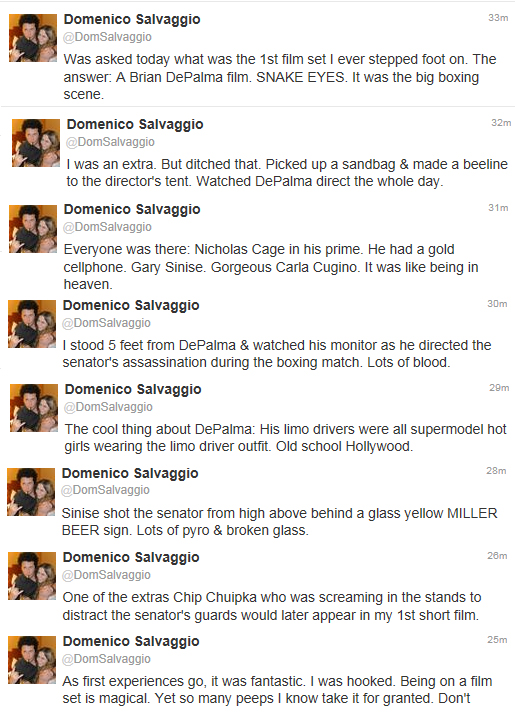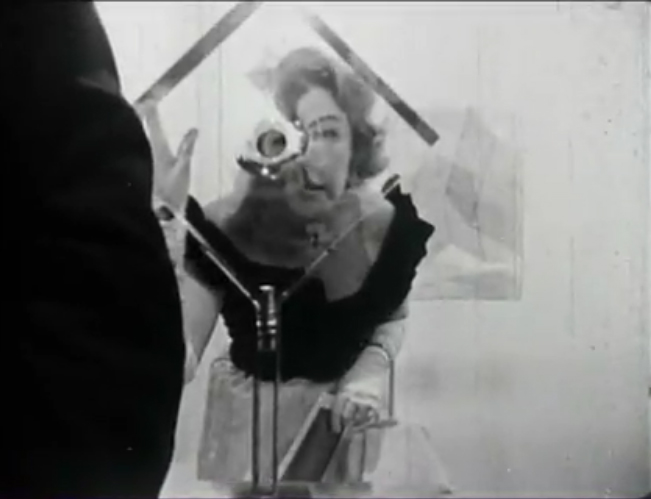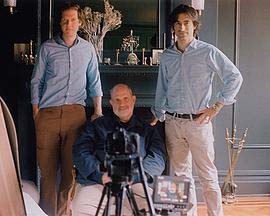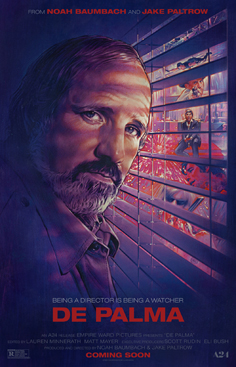
 Hello and welcome to the unofficial Brian De Palma website. Here is the latest news: |
|---|
E-mail
Geoffsongs@aol.com
-------------
Recent Headlines
a la Mod:
Listen to
Donaggio's full score
for Domino online
De Palma/Lehman
rapport at work
in Snakes
De Palma/Lehman
next novel is Terry
De Palma developing
Catch And Kill,
"a horror movie
based on real things
that have happened
in the news"
Supercut video
of De Palma's films
edited by Carl Rodrigue
Washington Post
review of Keesey book
-------------
Exclusive Passion
Interviews:
Brian De Palma
Karoline Herfurth
Leila Rozario
------------
------------
| « | May 2016 | » | ||||
| S | M | T | W | T | F | S |
| 1 | 2 | 3 | 4 | 5 | 6 | 7 |
| 8 | 9 | 10 | 11 | 12 | 13 | 14 |
| 15 | 16 | 17 | 18 | 19 | 20 | 21 |
| 22 | 23 | 24 | 25 | 26 | 27 | 28 |
| 29 | 30 | 31 | ||||
De Palma interviewed
in Paris 2002
De Palma discusses
The Black Dahlia 2006

Enthusiasms...
Alfred Hitchcock
The Master Of Suspense
Sergio Leone
and the Infield
Fly Rule
The Filmmaker Who
Came In From The Cold
Jim Emerson on
Greetings & Hi, Mom!
Scarface: Make Way
For The Bad Guy
Deborah Shelton
Official Web Site
Welcome to the
Offices of Death Records


Say whatever you want to about the school of painting and design known as "op art"...you've already been beaten to the punch by the vox populi caught on camera by Brian De Palma in 1966.In fact, the majority of the director's documentary account of the opening of the titular Museum of Modern Art exhibit dedicated to perceptual art -- art that, as John Lancaster put it, played with "the interaction between illusion and picture plane, between understanding and seeing" -- is given over to commentary from both artists and spectators about the effectiveness of pieces by Bridget Riley, Josef Albers, and Alexander Liberman. In their collective view, the work was deemed everything from stunning to nauseating. Or, as one interviewee says during the film: "I don't think it's art."
Any other director would have stuck with curator William Seitz and psychologist Rudolph Arnheim as they took them on a tour of the exhibit, teasing out their own interpretations of the art. Instead, De Palma turns the whole piece into one of the wittiest films of his oeuvre as well as a sly commentary on the state of the art world in the '60s. It's a neat trick, and one that he pulls off using the strongest part of his visual arsenal at the time: editing.
His use of jump cuts into dialogue from the interviews echoes the itchy movement of his debut feature The Wedding Party. In that film, he hearkens back to the work of directors like D.W. Griffith and Charlie Chaplin, not to mention the French New Wave filmmakers who were using the same artistic tricks: overly-caffeinated pacing and quick edits between two competing scenes.
With The Responsive Eye, many of the same storytelling devices are brought over to the documentary format. De Palma jumps between the discussions of Seitz and Arnhelm, and the reactions of people at the opening night event. They go by so quickly that the effect is as sometimes disorienting as the art on the walls of MoMa. They are short jabs of punch lines and little visual gags (the woman in an evening gown bending repeatedly at the knees to catch the "movement" of a piece she is looking at).
It's also important to look at the people that De Palma and his camera crew choose to interview for the film. They are an absurd bunch: the bespectacled child who declaims that he wouldn't put the art in his home, the woman dolled up for the night in a completely striped outfit ("The tights are from Macy's, and the dress is from Bloomingdales"), the drunken woman being held aloft by her husband saying, "I loved it," and the coup de grace, the caricature of an English nobleman at the very end, complete with a haughty air about him. And a monocle.
The only people you are meant to take seriously, it seems, are the artists behind the work. In that camp, you get Mon Levinson showing off how he creates the illusion of movement with his pieces, and discussing at the end how excited he was to see it. Best, though, is Josef Albers, who kvetches loudly about how long it has taken his work to be appreciated.
Albers may have a point, but it brings up one of the underlying issues of this film and this exhibit. As Marc Campbell on Dangerous Minds points out, Responsive Eye was "the first significant exhibit of optical art synchronous with and in some cases arising out of the early days of psychedelic culture." i It's amazing, really, that no one in the film addresses this fact. I think De Palma knew that going into the project, and although he doesn't press the issue, the point is simple: these folks just don't get it.
That kind of attitude was De Palma's whole mindset at this early stage of his career. The work he was doing before and after this documentary kicked against the ideas of Hollywood filmmaking. Beyond The Wedding Party, he helped create the two Godardian, politically-driven films, Greetings and Hi Mom!, and the slapstick slasher flick Murder a la Mod. Why would anyone expect him to make a dull documentary about an art exhibit?
 Jake Paltrow and Noah Baumbach will be on hand (and on stage) immediately following a June 5th screening of their new documentary, De Palma, which is the closing night film of this year's Berkshire International Film Festival, which runs June 2-5 in Great Barrington, Massachusetts. The discussion will be moderated by artist Gregory Crewdson. According to a Page Six item, Brian De Palma and Wes Anderson were among several celebrities who attended Crewdson's "Cathedral of the Pines" photography exhibition this past January at the Gagosian Gallery in New York City. "Known for his cinematic images," states Page Six's Ian Mohr, "Crewdson will make his debut as a film director with an adaptation of the book The Deepest Secret."
Jake Paltrow and Noah Baumbach will be on hand (and on stage) immediately following a June 5th screening of their new documentary, De Palma, which is the closing night film of this year's Berkshire International Film Festival, which runs June 2-5 in Great Barrington, Massachusetts. The discussion will be moderated by artist Gregory Crewdson. According to a Page Six item, Brian De Palma and Wes Anderson were among several celebrities who attended Crewdson's "Cathedral of the Pines" photography exhibition this past January at the Gagosian Gallery in New York City. "Known for his cinematic images," states Page Six's Ian Mohr, "Crewdson will make his debut as a film director with an adaptation of the book The Deepest Secret."


 This past week, it was announced that Brian De Palma's Phantom Of The Paradise will be included in the line-up of this year's Oak Cliff Film Festival, which takes place in Dallas June 16-19. The screening is a homecoming of sorts: parts of Phantom were filmed at the Majestic Theatre in Dallas, but the film has never played there. That will change on Friday, June 17, when Phantom will screen at the Majestic, "with an expected appearance by one or more of the film’s stars," according to a press release. "New Hollywood" is the theme for this year's Oak Cliff Film Festival, which will also include a screening of Noah Baumbach and Jake Paltrow's De Palma documentary (specific date/time to be announced).
This past week, it was announced that Brian De Palma's Phantom Of The Paradise will be included in the line-up of this year's Oak Cliff Film Festival, which takes place in Dallas June 16-19. The screening is a homecoming of sorts: parts of Phantom were filmed at the Majestic Theatre in Dallas, but the film has never played there. That will change on Friday, June 17, when Phantom will screen at the Majestic, "with an expected appearance by one or more of the film’s stars," according to a press release. "New Hollywood" is the theme for this year's Oak Cliff Film Festival, which will also include a screening of Noah Baumbach and Jake Paltrow's De Palma documentary (specific date/time to be announced).


 Shock Till You Drop's Chris Alexander posted a highly positive review of De Palma yesterday. "It’s a rapturous gift to the hardcore De Palma admirer, of which this writer is one, loud and proud," states Alexander. "In fact, so smitten was I by this picture, I watched it 3 times in succession. It’s a master class. The first and last word on the man and his work."
Shock Till You Drop's Chris Alexander posted a highly positive review of De Palma yesterday. "It’s a rapturous gift to the hardcore De Palma admirer, of which this writer is one, loud and proud," states Alexander. "In fact, so smitten was I by this picture, I watched it 3 times in succession. It’s a master class. The first and last word on the man and his work.""Mind you, De Palma is masterfully edited, cutting between the chatty director and a flurry of incredible clips from the films themselves (there goes the budget!) and behind the scenes stuff from De Palma’s vaults (love the 8MM footage of Steven Spielberg, De Palma’s former best friend and the director’s ex-wife, actress Nancy Allen, sending love out to their colleague; a beautiful snapshot of a time and place that exists only in myth). So, who knows how hard Baumbach and Paltrow worked to get their mentor into his comfort zone. Either way, they did and it’s amazing.
"DE PALMA will be an orgasmic experience for the faithful. But it is also required viewing for every aspiring director who dreams of making commercially successful product, while still maintaining the pure vision of an artist. Truly, it’s difficult to think of another Hollywood filmmaker who has so deftly managed to make such personal work on such a grand scale."
Jesse Hawken of Torontoist posted a review of the documentary last week, in anticipation of the Hot Docs Film Festival:
This film is a chronological tour of De Palma’s complete filmography, guided by the director himself with a bounty of clips and juicy stories about a career full of fights with actors (he had a tough time working with Cliff Robertson on his first big budget film Obsession), studios (Columbia Pictures wouldn’t let him cast the porn star Annette Haven in his erotic thriller Body Double), and the ratings board (which came to a head when he got an X rating for Scarface after submitting three versions, finally putting all the violence back in). De Palma is candid when discussing the highs and lows of his 50-year directing career: he passed on directing Flashdance and Fatal Attraction; he says he lost his nerve adapting Tom Wolfe’s The Bonfire of The Vanities; and feels he never made a better film than Carlito’s Way.The final section of the film is unexpectedly moving as it heads into the director’s decline, which began after his greatest box office success Mission: Impossible, as he got lost in making the visual-effects-heavy Mission To Mars; its spectacular failure at the box office was the end of De Palma’s American career, as he looked to Europe for financing and the years between features lengthened. As illustrated by the clips from his recent, less-consequential works like Passion and The Black Dahlia, De Palma understands, like his hero Hitchcock in the years after Psycho, that his glory days are behind him, that the industry has changed around him, that it gets harder as one gets older.
Directors Baumbach and Paltrow are obviously huge admirers of De Palma’s work, and the film succeeds as a solid testament to his career and importance. This film is a feast for De Palma lovers who may not be so familiar with the smaller, harder-to-see films from earlier in his career, like Greetings, Get To Know Your Rabbit, and Home Movies; conversely, this clip-heavy documentary might not be the best place to start for newcomers to De Palma’s work, as the twists and climaxes to some of his greatest films will be ruined for you, especially the magnificent downer ending of Blow Out.